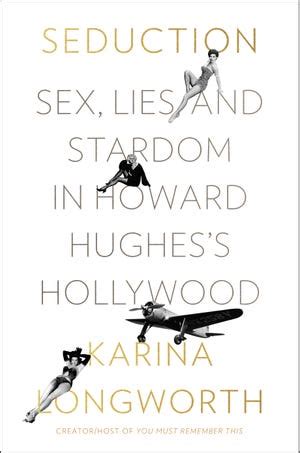Wealth, Glamour and Hollywood Sleaze
Two approaches tend to shape biographical studies. Most common, especially when it comes to figures of historical significance, is a focus on what the subject did. Be it writing, actions, discovery, crime, salvation or creative creation, these works give most of their attention to the subject’s accomplishments, good and bad. The second approach and more complicated approach is to focus on the subject as a person. Where did the come from? What were the major contours of their life? Celebrities often are treated this way, as we already know about their accomplishments. The second approach offers us a peek behind the curtain, a promise of what the subject was “really” like.
Karina Longworth’s Seduction: Sex, Lies and Stardom in Howard Hughes Hollywood appears, at first glance, to fall into the latter camp, a celebrity focused tell-all. Beautiful movies stars adorn the cover and are featured in photographs. That, however, is not the case for Longworth has a much different story to tell. Her dogged research and informed eye focuses on many of the key women in Howard Hughes’ life. It is not a pretty picture, one that runs counter to glossy accounts of “womanizing” and glamour. Seduction, which is far from a simple biography, explores the practice and culture of exploitation in Hughes’ Hollywood. Howard Hughes was not alone. Though not its intent, it is easy to understand draw a line from Hughes to Harvey Weinstein and his crimes.
First, a brief refresher on Howard Hughes. The richest man in the world, or close to it, he profited from his father’s creation, Hughes Tool, and spun that into many other successful businesses. He was a record-setting aviator, the founder of Hughes Aircraft and later the primary owner of TWA, Trans World Airlines. Hughes produced movies and purchased RKO studios, as well as becoming a significant philanthropist. Eccentric, Hughes’ became increasingly psychologically disturbed after several aircraft crashes. His latter years were spent in self-imposed hermit-like isolation, afraid of human contact.
Longworth is a writer, scholar, and the creator/host of You Must Remember This, a popular podcast about early Hollywood. In Seduction, she is interested in “what it was like to be a woman in Hollywood during what historians call the Classical Hollywood Era – roughly the mid-1920s through the end of the 1950s, the exact period Hughes was active in Hollywood.” After a brief marriage, Hughes’ relationships with women were all products of Hollywood, begging the question whether his was really keen on making movies or in finding attractive women. The answer is “both.” Seduction a multi-person biography and a study of Hollywood exploitation and power.
Many of the women linked with Hughes were supremely talented and famous. Billie Dove, Jean Harlow, Ida Lupino, Ginger Rogers, Katharine Hepburn, Jane Russell, Ava Gardner, Faith Domergue, Jean Peters and Terry Monroe all figure prominently in the book. Not all these women were in serious relationships with Hughes, though he seemed to have pressed for sex and promised marriage to nearly all. There were many other stars, too, that may or have not been in a relationship with Hughes, from Marlene Dietrich to Joan Fontaine. Hughes could be generous, and his philanthropy to the medical research, remains important to this day. He could also be extremely difficult to those around him, especially women. Hughes lied consistently and constantly. It was a function of his interpersonal behavior. He did all that he could to control many of the women in the book, from promises and bankrolling projects (or not), to hiring detectives to spy on them. Some of the relationships ended well. Others did not. After he hit Ava Gardner, she beat Hughes with a bronze bell and then a chair, splitting his forehead and knocking teeth loose. Violence like that was “fixed” by Hughes’ wealth and the culture and practice of Hollywood.
It is difficult to determine how many stars, starlets and aspiring actresses’ careers were derailed by Hughes. He certainly helped some, though there were many others who fell into semi-professional purgatory, hoping for a break that Hughes would never provide. While Howard Hughes was not alone in this kind of power game, he seems to have done it at scale for decades.
Longworth treats her women subjects as fully formed individuals, with hopes, histories and challenges. She humanizes the stars, making sure that we have an appreciation for where they had agency and where they did not. Longworth is also a film critic. Her accounts of the key films referenced in the book are very well done, giving well-known movie classics a different critical review.
Making judgements about the behavior of an historical figure is almost always fraught. Humans are complicated creatures, mixtures of conflicting impulses and characteristics that rarely add up. Moreover, our behavior is greatly determined by our circumstances. All that said, despite his many accomplishments, it is impossible to read Seduction and come away with a positive feeling about Howard Hughes. He was a damaged person, and as a colleague once reminded me, “hurt people hurt people.” Hughes hurt many of those around him. The glowing press, the womanizing, the parties and excess were products of a media machine. Longworth’s research reveals a wealthy many doing what he could when he could with little consideration for others – especially women. Take a close look at this “playboy” and it’s clear that there was very little play and a definite absence of good cheer, care or love.
Seduction is valuable contribution and corrective to our understanding of the “golden” years of Hollywood and Howard Hughes.
David Potash
